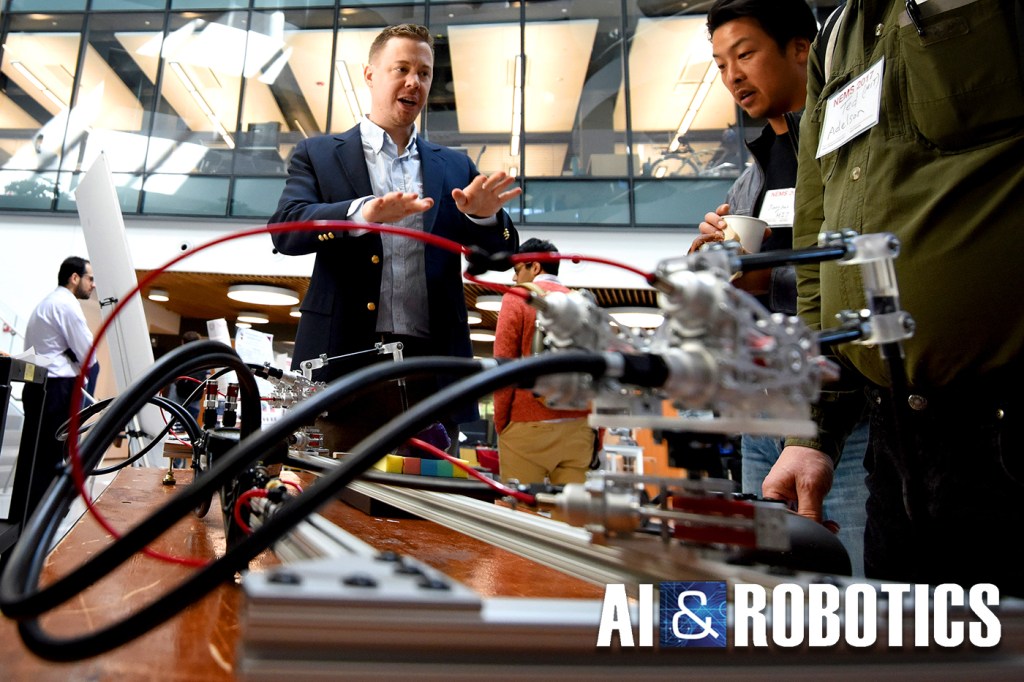Robots get a light touch

It’s the Holy Grail in robotics: an android that can perform complex tasks beside humans in a real-world environment.
The problem is that when robots are asked to operate outside a highly controlled environment, they tend to be slow and clumsy. The fast and precise robots that work so effectively in factories can’t work in real-world environments because they can’t immediately sense and respond to those environments. Ask them to quickly grab a fragile object, and they’re likely to crush it. Ask them to work beside a human, and they might accidentally break his arm or bump him off the loading platform.
If we want robots to work alongside humans, we have to make a gentler robot.
Peter Whitney, Northeastern engineering professor
“If we want robots to work alongside humans or handle complex tasks autonomously, we have to make a gentler robot,” says Peter Whitney, professor of engineering at Northeastern, who specializes in robot mechanics.
Whitney believes he has the answer: hydraulics.
While working at Disney Research in Pittsburgh, he developed Jimmy, a remarkably lifelike robot that’s fast, precise, and gentle enough to play catch with a balloon, pick up an egg, and pat a girl’s cheek without giving her a concussion.
For now, Jimmy is operated like a puppet by a human. This early incarnation demonstrates that Whitney’s hydraulic system can create a sense of touch that vastly expands the robot’s capabilities. It doesn’t crush the egg because the operator can feel its shell through hydraulic feedback; it doesn’t clobber the girl because the operator can feel her face as soon as the robot arm touches her.
Even though Jimmy is not yet autonomous, the hydraulic system has many applications. For example, Whitney is working with researchers from Stanford University to adapt his technology to perform robot-assisted MRI surgery.
Because an MRI tube is so narrow, doctors currently have to roll patients in and out of the tube as they perform surgery. Whitney is working with Stanford University engineer Mark Cutkosky to perfect a smaller version of Jimmy to perform surgery inside the tube, guided by a surgeon using the puppetlike controls. Because the hydraulic technology transmits a sense of touch, the surgeon would be able to actually feel what Jimmy is doing inside the MRI tube.
“Peter’s robots are elegant in their simplicity and can translate mechanical motion from one point to another with precision,” says Hata Nobuhiko, a professor at Harvard Medical School who is director of the program at Brigham and Women’s Hospital that adapts robotic innovations for medical use.
“It’s simple because it doesn’t rely on wires and motors and sensors to guide the robot,” says Nobuhiko. “It doesn’t require a computer to determine how much pressure to apply. In medicine, we don’t like that because too many things can go wrong. You don’t want that happening when you’re inside a human body.”
With Whitney’s hydraulic technology, Nobuniko says surgeons will be able to stand outside the MRI tube and precisely perform a prostate biopsy using Whitney’s “magic hand.” One of the advantages of Whitney’s hydraulic system is that it doesn’t require any magnetic or electrical material, which would distort the MRI imaging.
We want the physician to feel like her fingertips are inside the MRI machine pushing in the needle.
Mark Cutkosky, Stanford University engineering professor
“It’s the secret to what makes it so precise and light,” says Cutkosky. “We want the physician to feel like her fingertips are inside the MRI machine pushing in the needle.”
Whitney speculates that if he can miniaturize key parts of the hydraulic system, his technology might be adaptable to laparoscopic surgery.
“Laparoscopic surgery is now completely numb,” says Whitney. “All of the surgeon’s movements are controlled by sight, nothing by feel. That’s because there’s no accurate force feedback.”
Autonomy
The next step, he says, is to use his system in autonomous robots, combining the speed and precision of industrial robots with the gentleness needed to work alongside humans. The potential applications are enormous, ranging from eldercare and rescue work, to hazardous waste removal and space exploration. Whitney says the target for this technology is any work that requires a robot to be precise and fast in one moment and compliant and gentle in the next.
Whitney is collaborating with Northeastern computer science professor Robert Platt, who is developing the artificial intelligence needed to perform autonomous tasks—particularly grasping and manipulating common household objects so a robot can be used for jobs such as feeding and shaving.
“With Jimmy, we demonstrated what the hardware will be physically capable of when the artificial intelligence catches up,” says Whitney. “Even though it’s still human controlled, it proves that an autonomous application is possible.”
Low-cost solutions
Whitney’s hydraulic system also has the potential to dramatically reduce the cost of agile robots. This is particularly important in the home setting, where customers don’t have the financial resources of manufacturing companies. His goal is to develop a robot arm with at least seven joints and that could be mounted on a wheelchair or robot-wheeled base.
“We’re hoping to keep the cost under $2,000, which could be cut in half through mass production.”





